Injunction by Noticed Motion
If you believe that someone is likely to take an action that will violate your rights, you can ask a court to issue a preliminary injunction prohibiting (“enjoining”) the action until the case between you and the other party is over. It takes more than three weeks to get a preliminary injunction (sometimes much more). There are no fill-in-the-blanks forms for an injunction, and there are several steps involved.
Before requesting an injunction, you must start a lawsuit regarding the underlying problem or conflict. Unless you have already sued the party you want enjoined, the first step is to file a Complaint in court. This guide does not cover how to write the initial complaint, since it will need to fit your particular circumstances.
Templates and Forms
- Complaint Supporting Injunction Template – RTF (if not yet filed)
- Motion for Injunction Template – RTF
- Order Granting Injunction (Noticed Motion) Template – RTF
Fee and fee waiver. There is a fee for filing a Complaint. For an unlimited civil case the fee is currently $435. The fee for filing a Motion is $60, but if you file your Motion along with the Complaint, this fee will be waived. Check the current Sacramento County filing fees before filing. If you are low-income and/or receiving certain benefits, you may qualify for a fee waiver. See our Fee Waiver guide for details.
Warning: This is a complicated procedure with several steps. You will be expected to follow all the same rules as a lawyer would. You will need to do extensive research and writing—we simply provide the format. You will probably have to go to court and speak in front of the judge, the other side, and an audience. If you cannot or prefer not to do these tasks, you will need to hire an attorney.
Notice: The judge may (in some cases, must) require you to post a bond that will be used to compensate the defendant for any losses if the judge later decides the injunction was improperly granted. You will need to obtain this bond from a surety bond company, which will require a deposit and a fee.
Before the Motion: Research and Write Your Complaint and Accompanying Papers
Skip to Step 1 if you have already started a lawsuit against the defendant.
Write the Complaint. You need to sue the person or people whose actions threaten to violate your rights. See our guide “Filing a New Civil Lawsuit” for more information and required forms. If you want a permanent injunction at the end of the case, you must file an unlimited civil case. Include one cause of action for an injunction against the party or parties to be enjoined.
This guide includes a template complaint with cause of action for injunction. It will not fit your circumstances exactly and must be customized. Note: The filled-out samples in this guide are specifically for the Motion for Injunction. For more information about completing a summons and complaint, please use our guide on Filing a Complaint to Start a Civil Case.
You can file the Complaint and Motion together if you file at the Hall of Justice, 813 Sixth Street, in downtown Sacramento. Usually the Complaint is filed at the main courthouse, at 720 Ninth Street, also in downtown Sacramento.
Step-by-Step Instructions
1
Schedule the Hearing
This information is for Sacramento. If your case is in a different county, do not follow these instructions. Instead, call the clerk or visit the court website in your county to find the correct information.
Determine the department and time of the motion
In Sacramento, most motions are heard in the “Civil Home Court” department assigned to the case, which will be either department 25, 28, 53, or 54. Check your case file online to find which department your case is assigned to.
Note: Prior to November 10, 2025, each civil case was assigned to either Department 53 or 54 for most motions. If your case was filed before that date, its assigned department may have changed, so check before scheduling a hearing.
More information about Civil Home Court department transition
A few types of motions are heard in other departments. Check which departments hear which types of motions in Sacramento on the Civil Motions webpage.
Reserve the date for the hearing
In the Civil Home Departments, you must reserve a court date through the court’s online reservation system. For other departments, contact the department clerk to determine the procedure.
To use the online system, go to the Sacramento Court Public Portal and choose “Reservation System (CRS).” You must have a free account on the system to use it.
Before you log on or call, figure out if there are any days you will not be available during the next couple of months. For instance, you don’t want to pick a date when you know you will be out of town.
You must choose a date far enough in the future that you can both file and serve your motion on time. Scheduling it four weeks in advance generally gives a comfortable margin for most types of motions. Usually, the first available date will be further away than that.
Determine the legal deadline to file the motion in court
Disclaimer! Some motions have different time requirements. Check the rules for the motion you are filing.
Tip: File the motion as soon as possible. Your reservation is not final until the motion has been filed and any fees paid.
The last legal day to file with the court is at least sixteen court (business) days prior to the motion date (CCP § 1005). “Court days” are Monday through Friday, excluding court holidays.
NOTE: the court must receive the documents by that day. Postmark will not count.
To determine whether a particular filing date will meet this deadline, start counting backwards on the day before your hearing until you reach the sixteenth court day. (CCP § 12c)
For example, suppose your reservation is for Monday, June 18. You would start counting backward using the previous court day, Friday, June 15, as day one, as shown in the calendar below. Skip weekends and court holidays (there is one court holiday in this example, which is Memorial Day, May 28). The sixteenth court day before the hearing would be May 24, which would be the last day that the motion could be filed.
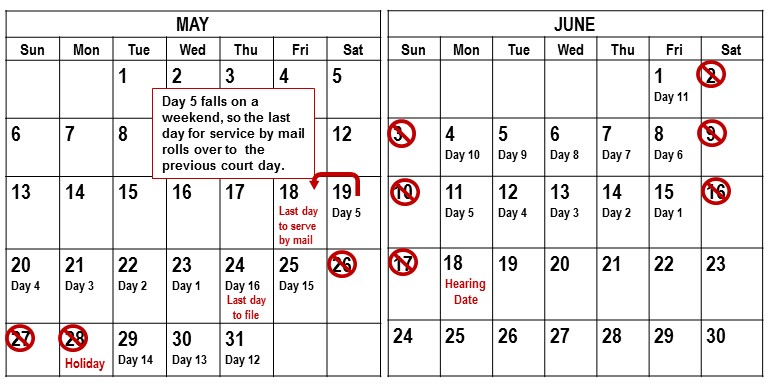
Make a note on your calendar to file the motion by this date. Do not miss this deadline. The court will cancel the hearing and you will have to start over.
Determine the legal deadline to serve the motion on the other parties or their attorneys
You must have a copy of the motion served on all other attorneys (or self-represented parties) by a strict deadline set by law. Earlier is always fine.
Personal service: 16 court days before the hearing, the same as the minimum filing deadline. The server should fill out Proof of Personal Service—Civil (POS-020).
Service by mail: 16 court days before hearing PLUS five calendar days before the hearing (more if the mailing address is outside California). (CCP § 1005). The server should fill out Proof of Service by First-Class Mail—Civil.
“Court days” are business days – Monday – Friday, except holidays.
“Calendar days” include weekends and holidays, but if the final day lands on a weekend or holiday, it is pushed back to the previous court day.
Make a note on your calendar to have the motion served by mail before the mail deadline. If you miss the mail deadline, you can still have the motion served by personal service up until 16 court days before the hearing. If you miss that deadline, you will have to cancel your court date and start over.
2
Research and write your declaration and memorandum
In your papers, you must explain the facts of your situation, explain the law, and demonstrate how the law applies to those facts. This usually requires original research, analysis, and writing. At the end of this guide, you will find a list of reference books with good starting points for civil motion research.
There are no Judicial Council forms for most civil motions. Instead, the relevant documents must be typed on 28-line pleading paper.
For tips and examples of how to write a declaration and what should be included, see our article “Declaration Tips.”
You will find forms and customizable templates linked at the tops of our guides.
Note: There is no pre-printed form for most motions for injunction. You will need to customize a motion on “pleading paper.” Instructions and a sample motion are at the end of this guide.
Declaration Tips
Your declaration must contain only facts you personally know to be true.
If someone else knows facts or took pictures you need to prove your argument, have them fill out and sign their own Declaration. They can use our template or write or type it on the standard form MC-030, Declaration.
Your Declaration should be consistent with the facts set forth in your Complaint, but is typically written in the first person, since it is the statement of the person signing the Declaration. Unlike the Complaint, which may contain facts for several causes of action, the Declaration supporting the Motion should focus on the specific facts that the court must consider in deciding whether to grant an injunction. You will sign it under penalty of perjury. Each separate fact should be explained in a numbered paragraph, so that you can easily refer to that fact in other documents.
The Declaration is the most important part of the Motion. The judge generally makes a decision on the Motion the day before the hearing date, based only on the paperwork, so the Declaration(s) and exhibits must contain everything needed justify the injunction.
It is possible to have more than one supporting Declaration. If your Motion relies on statements by someone other than you, you should obtain a Declaration from the person who made those statements to avoid problems with “hearsay.” Chapter 16 of Nolo’s book Represent Yourself in Court, which is listed as a resource at the end of this Guide, has a good, plain-English description of the evidence rules regarding hearsay. If obtaining a Declaration from the person who made the statements is not possible, you will need to research whether there is an exception to the hearsay rule that will allow the court to consider your evidence.
Attaching Exhibits
Documents and photos can be attached to a Declaration as exhibits. In the Declaration, identify the document with language such as:
14. I am the registered owner of a 2002 Toyota Corolla, license plate number 3TXS596, Vehicle Identification Number (VIN) 7842084092307 (“the Vehicle”). A true and correct copy of the registration certificate is attached as Exhibit “A.”
In the above example, you would then photocopy the registration and write “Exhibit A” on the bottom of the first page. If an exhibit is longer than one page, number each page. If you have other documents to submit, use the same “true and correct” language to attach them as Exhibits B, C, and so forth.
For each exhibit attached to your motion, you must place a page in front of the exhibit identifying it as Exhibit A, B, and so forth in alphabetical order.
A number of rules of evidence govern whether the court may consider a document, typically requiring the declarant to set up a sufficient “foundation” for it to be considered within the declaration. Chapter 15 of Represent Yourself in Court, on exhibits, has a good explanation of what you must include for the court to consider different types of evidence.
3
Assembling and copying papers
E-filing is now available in Sacramento. Self-represented parties can choose to file papers by electronic filing, but are not required to. Attorneys are required to use e-filing for most things. To use e-filing, you will need to select a third-party provider and email your paperwork to them. For more information on this in Sacramento, visit the Sacramento court’s e-filing information webpage.
If you do not use e-filing, follow the instructions on this page.
Make enough copies of your papers to serve one set on each party in the case, plus an optional one for you to keep. Staple the copies, but leave the original unstapled so it can easily be scanned into the court’s file system.
The original and your optional copy are to be filed with the court. You should get the copy back after the clerk stamps (“endorses”) it. You can also download a stamped copy from the online portal within a few days.
For each exhibit attached to your motion, you must place a page in front of the exhibit identifying it as Exhibit A, B, and so forth in alphabetical order, or Exhibit 1, 2, and so forth in numerical order.
4
Have Your Documents Served on the Attorney(s) or Self-Represented Party(s)
You must have someone serve your papers on the other attorney or self-represented party in the case. (If there are more than two parties, you must serve all parties, or their attorneys if they have one).
Service must be complete 16 court (business) days before the hearing date, plus five calendar days if you have it served by mail.
Tip: If the mailing deadline (16+5 days) has passed, but there are still more than 16 court days before the hearing, you can have it served by personal delivery. If you miss the service deadline entirely, you will need to re-schedule your motion.
Proof of Service form:
After service is done, you will need to file a Proof of Service signed by the server. If serving by mail, you can use Proof of Service by Mail (POS-030). For personal service, use Proof of Personal Service (POS-020). You can fill most of the Proof of Service out now, but it should not be signed. Make a copy of the unsigned proof of service before proceeding and include it with the motion papers when you have them served.
After serving the papers, your server will sign the Proof of Service form, and give it to you.
Attach the original signed Proof of Service to your original signed motion. If you are using an optional copy for yourself, attach a copy of the Proof of Services to that.
You can also file it as a separate document, without attaching it to your motion papers.
Note: Serve Complaint Along with Motion if You Have Not Served it Yet
- If you have already served the Summons and Complaint, you can use Proof of Service by First Class Mail (POS-030) or Proof of Personal Service (POS-020) for the motion. For more information on these Proofs of Service, see our guides for Serving Documents by Mail and Service by Personal Delivery.
- If you are also serving the Summons and Complaint, use Proof of Service of Summons (POS-010) and list all the documents on that paper. The Summons and Complaint must be personally served; you can serve the Motion paperwork along with it.
5
Assemble your Documents for Filing
Assemble your packet for filing as follows. The original should be unstapled, while any copy is stapled.
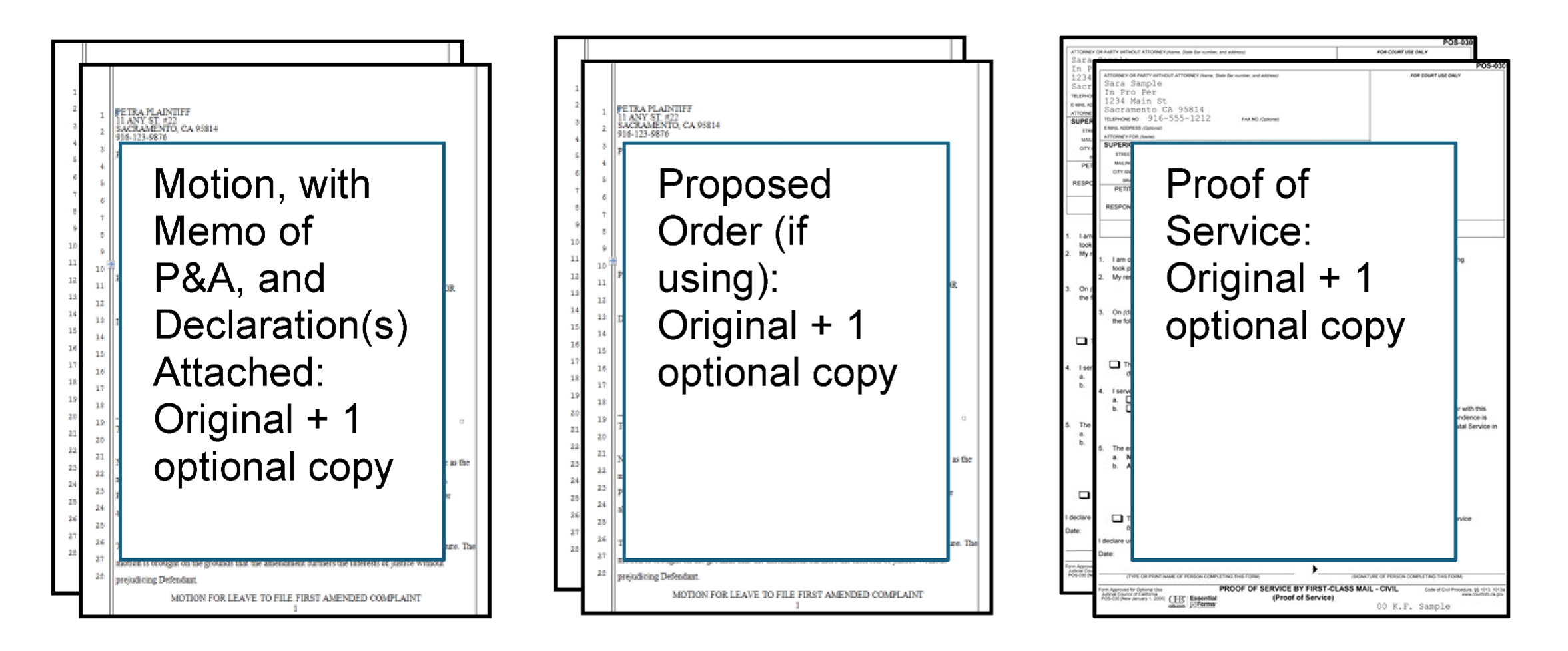
- Motion, including Memorandum of Points and Authorities and Declaration with exhibits: original plus one optional copy to be returned to you.
- Proposed Order, if included, plus one optional copy.
- Completed Proof of Service form: The original plus plus one optional copy. This proof of service can filed as its own document, or it can be attached as the last page of the Motion when filing. If it is attached, then attach the original signed Proof of Service to the original signed Motion.
- Any other documents, such as Request for Judicial Notice, should be treated the same way: create a stack of original plus one optional copy and file along with the others.
If you are submitting the papers in the dropbox, you will find cover sheets and large binder clips to hold the whole package together near the box.
6
File at the Hall of Justice Building
All moving papers, oppositions, and replies can be e-Filed, mailed to 720 9th Street, Room 102, Sacramento, CA 95814, or filed in person at the Hall of Justice Building, 813 6th Street, Room 212, 2nd Floor Sacramento, CA 95814.
Note: If you file in person, go to 813 6th Street for all departments (even though Dept. 25 and Dept. 28 are physically located in the main courthouse at 720 9th Street).
Your options are:
- Wait in line to file with the clerk in Room 212.
- Drop your paperwork and payment in the dropbox in the lobby. Payment must be by check or money order. Your papers will be marked as filed on the day you place them in the box if they arrive before 5 p.m.
- Mail your paperwork and payment to: 720 9th St., Rm 102, Sacramento CA 95814. Payment must be by check or money order. Your papers must arrive by the due date; the postmark will be ignored.
- Use the court’s efiling system. This system is optional for self-represented litigants. Fees will be paid to the electronic filing service provider, which forwards them to the court.
At this time there is a $60 filing fee for a motion, unless your fees were waived. Dropbox filings must include a check or money order/cashiers check, no credit cards. Credit cards can be accepted at the counter or used when efiling.
Fee Waiver: If you are receiving government benefits such as Medi-Cal or are otherwise qualified because of low income, you can apply for a fee waiver. If you do not yet have a fee waiver, turn the fee waiver request forms in with the motion instead of a fee payment. For more information, see our Step-by-Step guide on Fee Waivers.
First Appearance Fee: If you are filing the Summons and Complaint along with the Motion, the court will assess a first appearance fee of $435 for an unlimited complaint. This fee sometimes changes. Check the Statewide Fee Schedule for current fees.
7
Opposition Papers and Your Optional Reply Papers
If any opposing counsel or self-represented party opposes your motion, he or she may serve and file an opposition at least nine court days prior to your motion. No fee is required to file an opposition. The opposition contains a memorandum of points and authorities and usually a declaration, but does not need the notice of motion or motion. Be sure to check your mail, and read any documents you receive carefully.
If another attorney or party opposes your motion, you may choose to serve and file a reply to the opposition at least five court days prior to the motion. CCP § 1005. It must be served by overnight mail to reach the opposing party no more than one day after it is filed.
The reply is optional and is usually used to address new issues your opponent raised in the opposition. No fee is required to file a reply. See the our guide on Writing, Scheduling, and Opposing Motions for more information.
8
Review Tentative Ruling at 2 p.m. the Court Day before the Hearing; Schedule Argument by 4 p.m. if Necessary
Most California courts use the tentative ruling system. In Sacramento, pursuant to Local Rule 1.06, the Civil Home Court departments issue tentative rulings on the motion by 2:00 p.m. the court day before the hearing. You then have two hours to request oral argument, if you choose to do so. Other departments may have different times or may not use tentative rulings; check with the department clerk.
Warning!
Your hearing will be canceled
If neither you nor the other party calls the court, the hearing will be canceled and you will not be permitted to talk to the judge.
You may read the tentative ruling online or call the assigned department to hear it. For more information, see the Sacramento County Superior Court’s Civil Tentative Rulings page.
Closely review the Tentative Ruling. If you are making the motion, you are looking for your motion to be “GRANTED.” If you are opposing the motion, you are looking for the motion to be “DENIED.” The motion may also be “GRANTED IN PART” and “DENIED IN PART.” The judge sometimes orders the parties to appear, even if neither party requests oral argument.
Losing party: If you are not happy with the Tentative Ruling, and wish to present oral argument in front of the judge, you must call all opposing counsel and/or self-represented parties, and the clerk for the department hearing the motion, no later than 4:00 p.m. the court day before your hearing and state that you are requesting oral argument. Note: carefully consider whether it is worth your time to request oral argument. It is very rare for judges to change their mind, but it does happen sometimes.
Winning party: If you are happy with the Tentative Ruling, you do not need to do anything unless the Tentative Ruling orders you to appear, or the other side calls you before 4:00 p.m. that day to request oral argument. If that happens, you should go to the court hearing and be prepared to argue your case.
If neither party requests oral argument by 4:00 p.m., the court will simply make the tentative ruling permanent, and no oral argument will be permitted.
9
Attend the Hearing, if Required
If you or the other party request oral argument, arrive in court or log onto Zoom early. There will probably be other cases scheduled at the same time; there is usually a list posted on the wall outside the courtroom that lists the order in which cases will be heard. Go into the courtroom or Zoom waiting room and check in with the bailiff or clerk.
In Person
If your Home Court Department is Dept. 53 or 54, you will go to 813 Sixth Street, second floor.
If your Home Court Department is 25 or 28, you will go to 720 9th Street, fourth floor.
When your name is called, be ready to speak and to answer any questions the judge has. You will only have a few minutes. After both sides speak, the judge may make a decision right away, or may “take it under consideration” and mail out the decision in a few days.
If you have questions about the order, you can ask them at the hearing. Make sure you understand if you are expected to do something as a result of the order. For instance, if you are ordered to file an amended complaint or serve responses, make sure you know the deadline and what is expected.
Next Steps
The Lawsuit
The defendant(s) must file a response to the Complaint within 30 days of being served. If they do not, you can request a default judgment (see our guides on “Request a Default Judgment by Clerk” and “Request a Default Judgment by Court”). If they do respond, the parties can begin discovery, the process by which you gather information to prove your case. Visit our Discovery topic page for a series of videos and guides on discovery.
Enforcing the Injunction
If the judge grants the injunction, but the other party disobeys it, you can file a declaration requesting that the judge find them in contempt of court. CCP §1211(a). If you can prove the defendant guilty beyond a reasonable doubt, they may be fined up to $1000, jailed for up to five days, or both. CCP §1218(a). You can find more information on that in some of the books listed below.
For more information
On the Web
Sacramento County Superior Court
“Filing Instructions and Procedures: New Complaint, Petition, or Appeal of the Labor Commissioner”
This page explains filing procedures for various types of papers, including new complaints.
“Motions and Hearings”
This page contains information on motions in Sacramento.
At the Law Library
California Forms of Pleading and Practice (KFC 1010 .A65 C3)
Chapter 303, “Injunctions,” has in-depth information on temporary restraining orders and injunctions, including information and forms for enforcing injunctions via contempt. Other chapters have sample complaints for various causes of action which you may use to write your Complaint (Step 1).
Electronic Access: On the Law Library’s computers, using LexisAdvance.
California Civil Procedure before Trial (KFC995 .C34)
Chapter 32, “Injunctions and Other Provisional Remedies,” has in-depth information and includes a section on enforcing injunctions via contempt.
Electronic Access: On the Law Library’s computers, using the OnLaw database.
Win Your Lawsuit (KFC 968 .D86)
This book does not cover restraining orders, but it can help you draft the underlying complaint. It contains sample filled-out forms for breach of contract, personal injury, and related causes of action.
Represent Yourself in Court (KF 8841 .B47)
This book contains information on preparing for and conducting hearings. Chapter 16 has a good, plain-English description of the evidence rules, including hearsay.
Electronic Access: From any computer (Library or home) via the Legal Information Reference Center. Instructions to access the LIRC
California Causes of Action (KFC 1003 .C35)
This book describes many of the common causes of action. It comes with a CD-ROM with sample complaints that you can download and customize.h
Samples
Motion for Injunction with Instructions
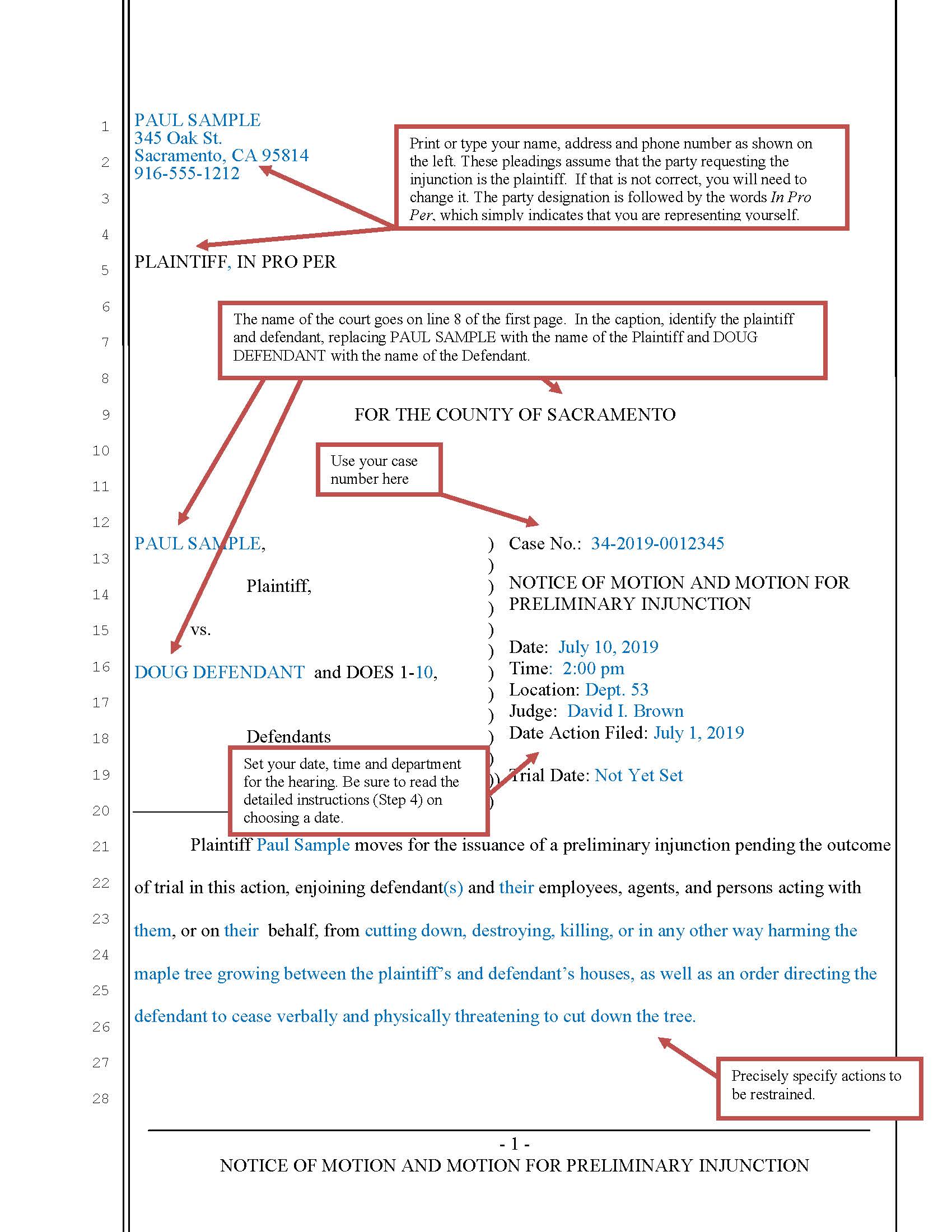
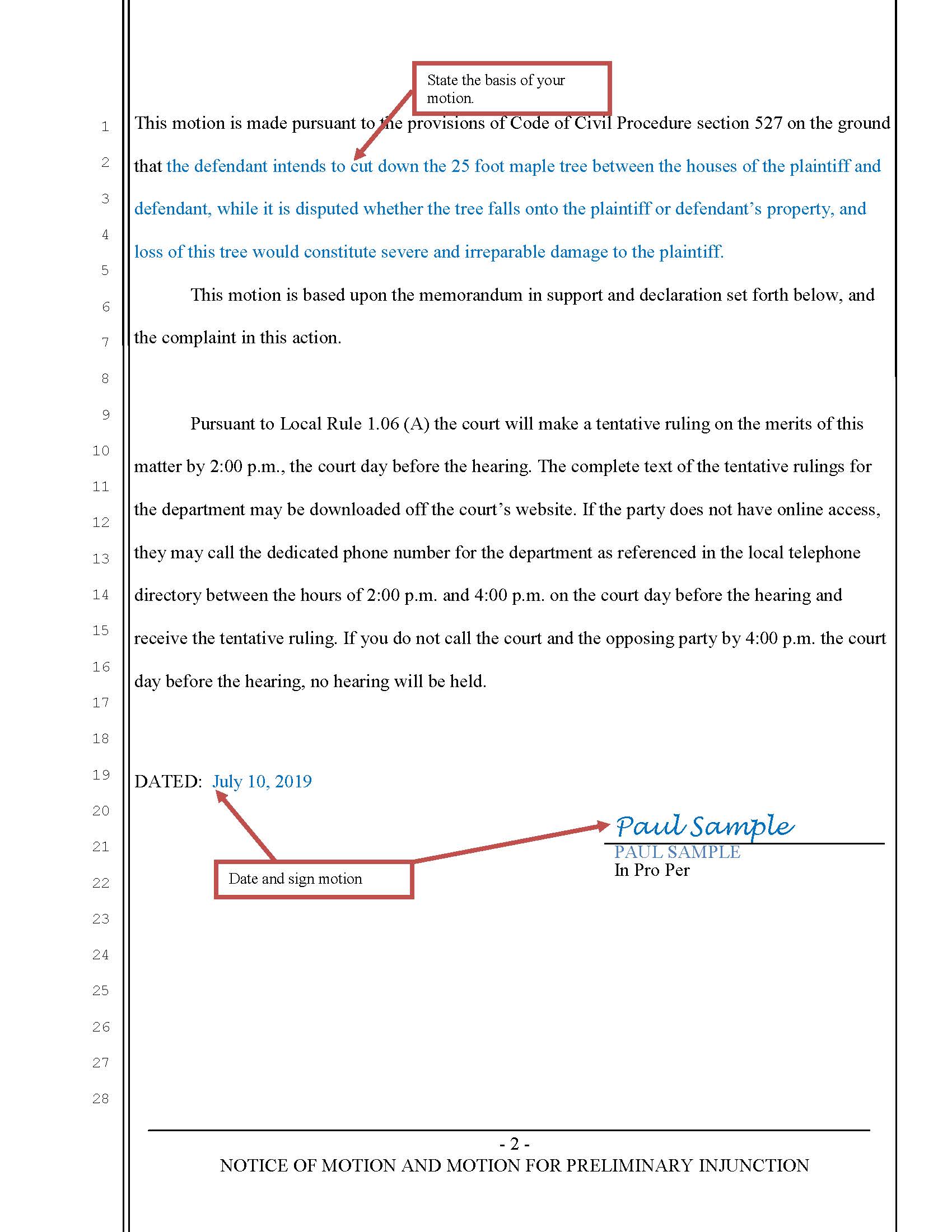
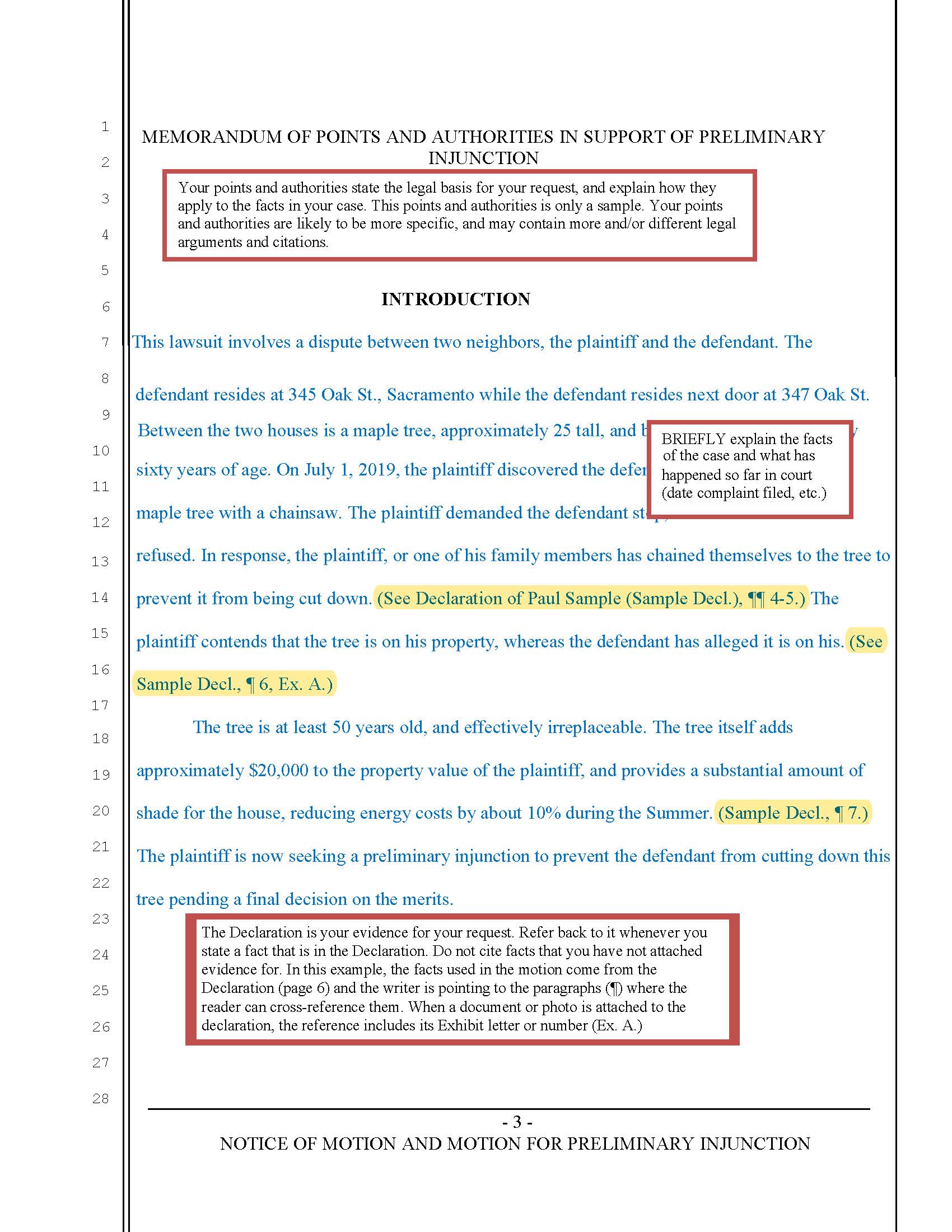
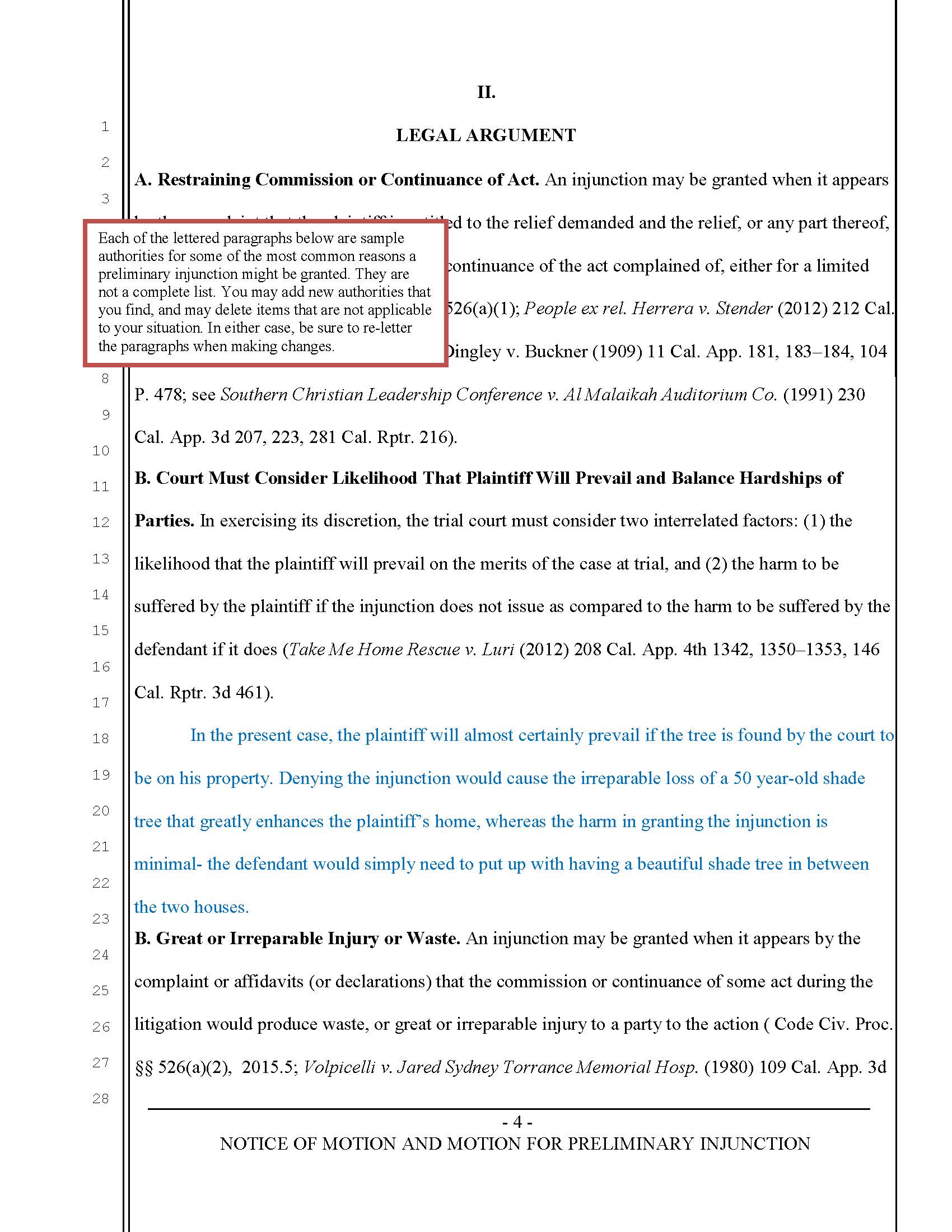
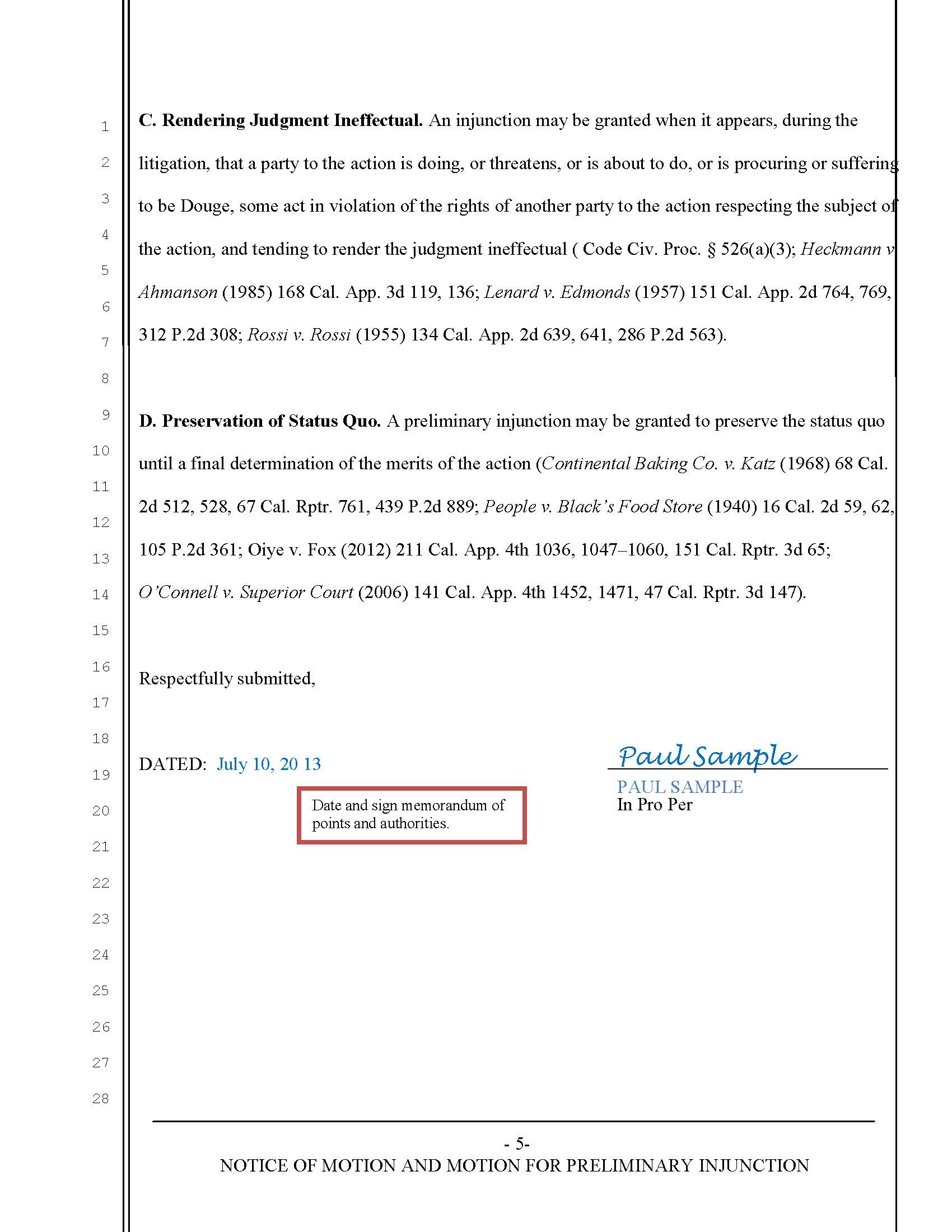
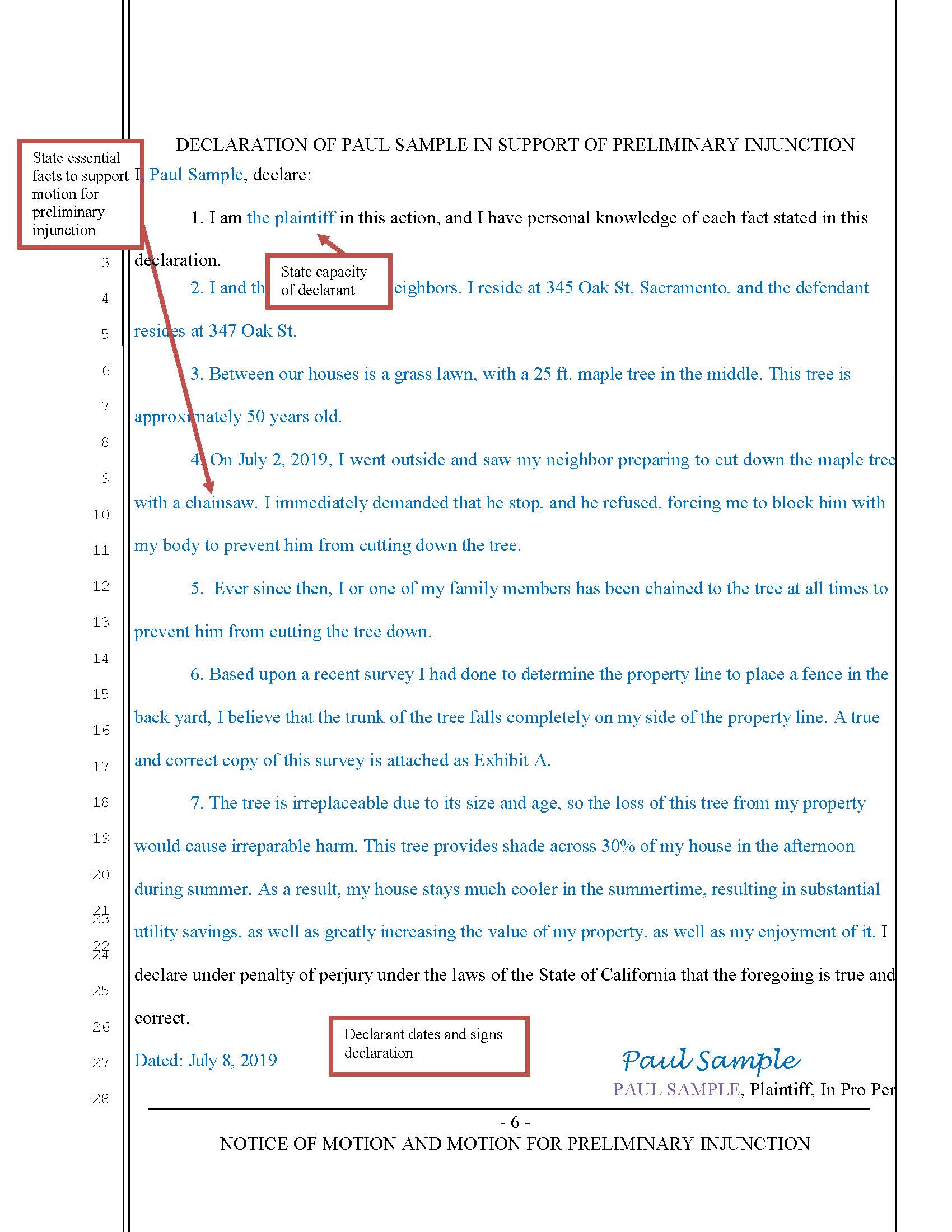
Sample Proposed Order with Instructions
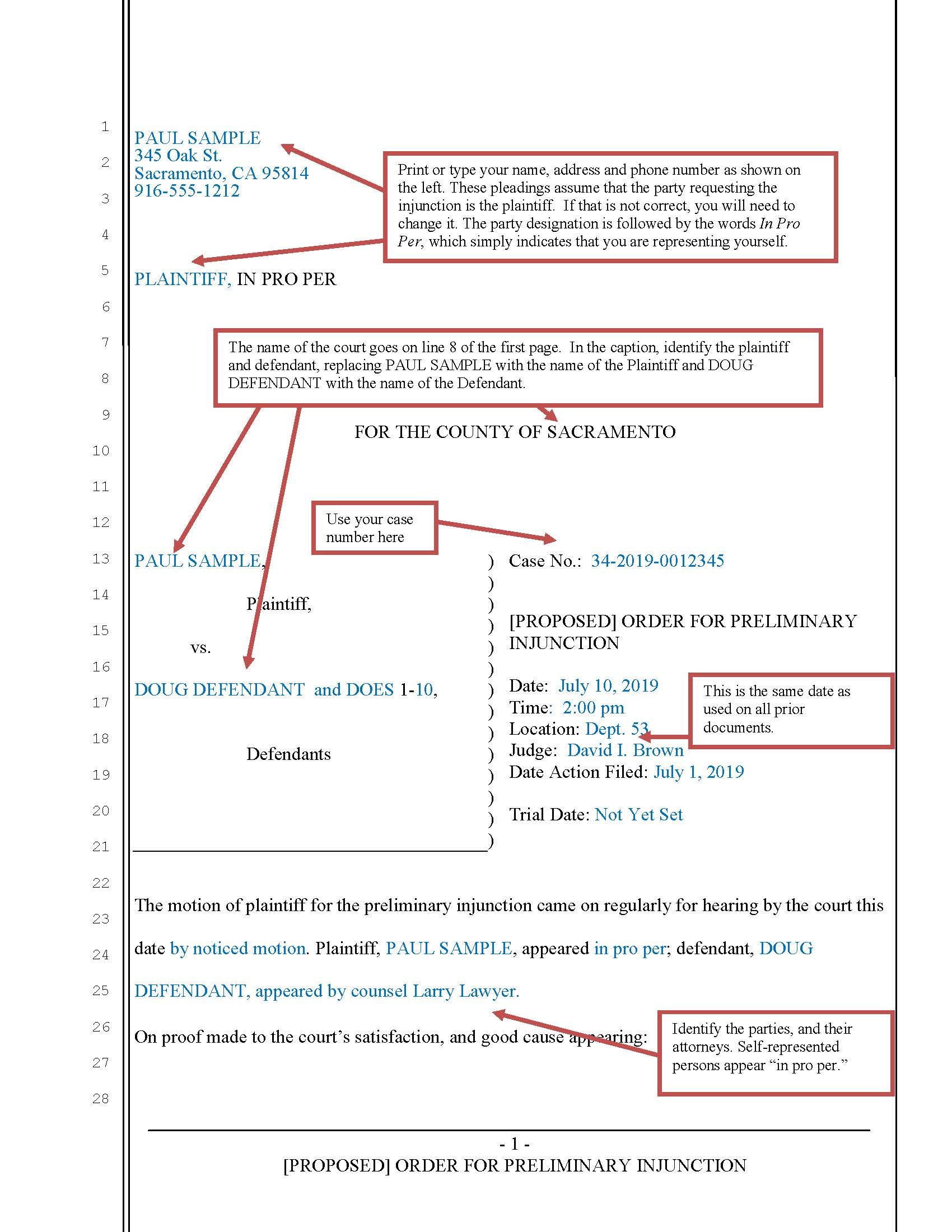

This material is intended as general information only. Your case may have factors requiring different procedures or forms. The information and instructions are provided for use in the Sacramento County Superior Court. Please keep in mind that each court may have different requirements. If you need further assistance consult a lawyer.




